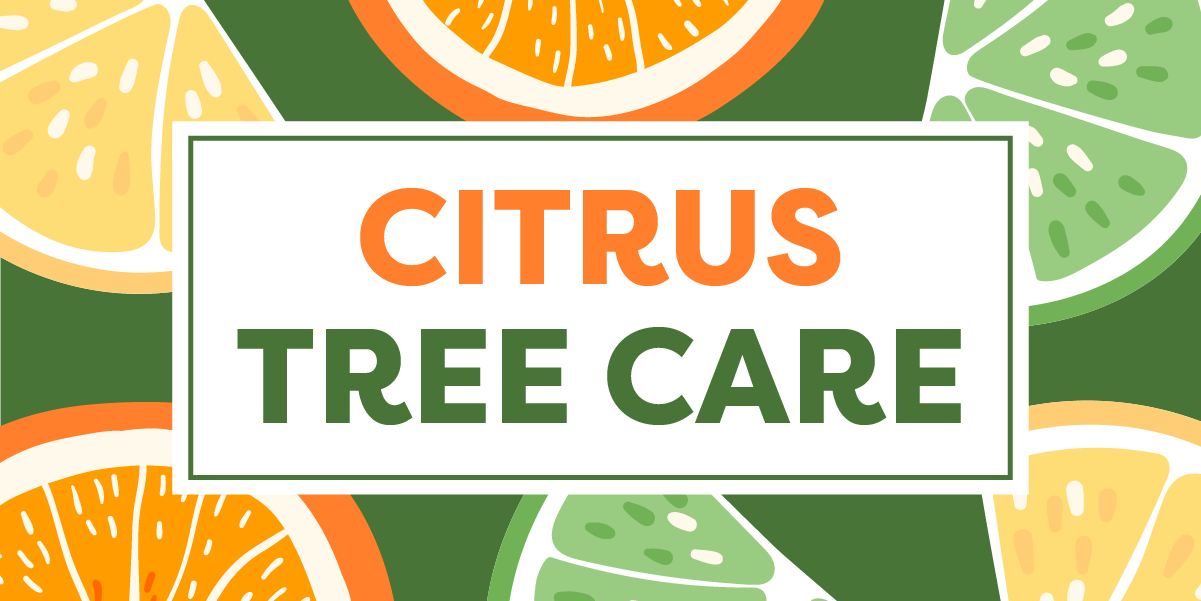There was a time when citrus trees grew everywhere in Southern California.
You’d see them on the way to school, church, the root beer stand, or wherever you were heading. New housing tracts were planted squarely in the middle of active citrus groves.
Even now, citrus agriculture contributes over $7 billion annually to California’s economy and employs more than 22,000 people.
Citrus trees probably originated in the foothills of the Himalayas, encompassing parts of modern-day India, Myanmar, and China. The genus is native to South Asia, East Asia, Southeast Asia, Melanesia, and Australia.
Most citrus will grow in Southern California; however, the varieties we list below will show mature fruit faster, tolerate cold weather better, and adapt to most soil types.
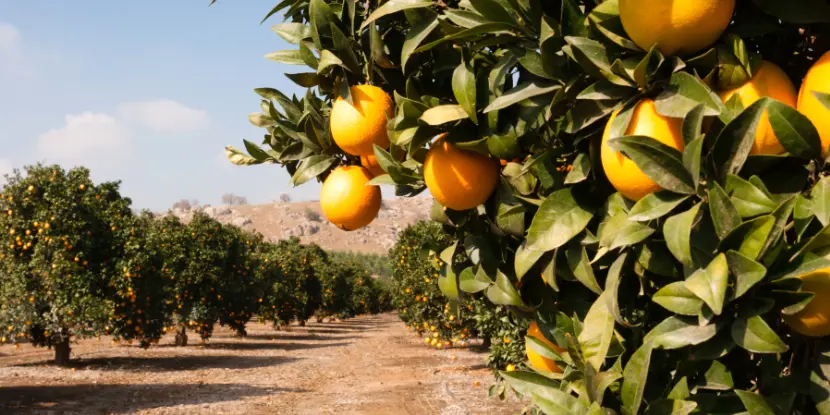
A commercial citrus farm.
Best Citrus Varieties for Southern California
Meyer Lemon
- Thick-skinned citrus fruit
- Very juicy and less acidic than standard lemons
- Bears fruit at an early age
Persian Lime
- Small, tropical, thorny shrub with excellent, seedless fruit
- The fruit is small and green to yellow-green
Ruby Red Grapefruit
- Sweetest, least tart of all grapefruit
- Fruit grow to regular size
- Red blush of skin with pinkish flesh
Sweet Kumquat
- Bright orange fruit, oval-shaped and one-inch long
- Sweet, edible rind. Tart flesh
- Excellent for eating or marmalade or jelly
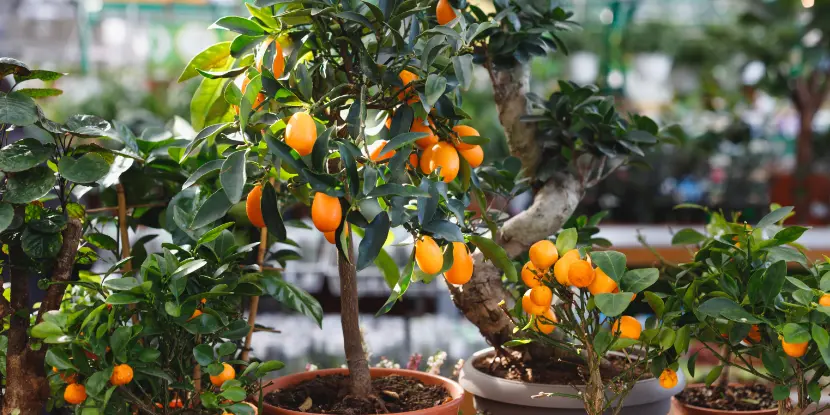
Small kumquat trees growing in pots.
Satsuma Orange
- Sweet, delicate flavor, few seeds, and medium to large fruit
- Easy to peel
- Fruit ripens early, generally by October, far ahead of cold weather
- Grows 6 to 8 feet tall and wide
Navel Orange
- Sweet, seedless fruit
- Best eating orange
- Thick-skinned but easy to peel
- Fruit ripens from December to May
Valencia Orange
- Vigorously growing tree
- Thin-skinned fruit
- Known as the juice orange
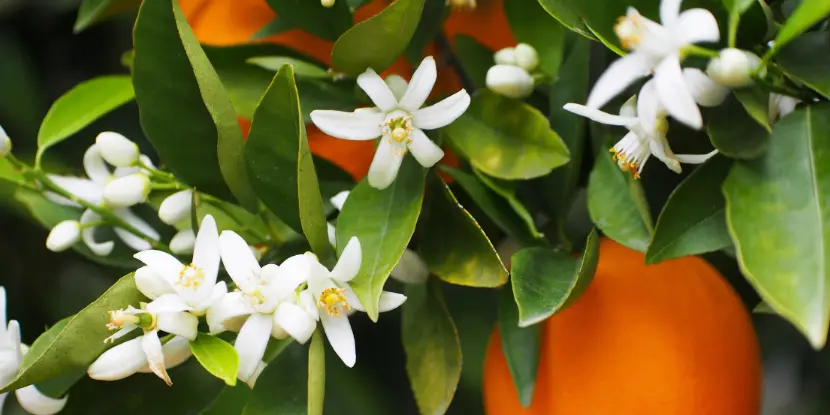
A flowering Valencia orange tree.
Calamondin Orange
- Small, tropical, evergreen citrus tree
- Noted for its relative hardiness, ornamental form, and foliage
- Small, juicy, acidic fruit with deep orange skin
Louisiana Sweet Orange
- Juicy citrus with medium-sized, flavorful fruit
- Medium skin
Tangerine
- Medium size fruit with good flavor
- Upright-growing tree with erect branches
Tangelo
- Cross between an orange and a tangerine
- Slightly larger than the tangerine
- Very easy to peel
Soil Preparation
Citrus trees will grow in any well-drained garden soil, from sand to clay, though these extremes are less desirable than a medium loam. Plant your citrus trees above soil or in raised beds in poorly drained soils. Slope the soil gradually away from the trunk.
Select the Planting Site
- Choose a sunny location that receives at least 6–8 hours of sunlight daily.
- Ensure the site is well-drained to prevent waterlogging.
Test the Soil
- Conduct a soil test to determine the pH level and nutrient content.
- Citrus trees prefer slightly acidic to neutral soil with a pH of 6.0-7.0.
Amend the Soil
- If the soil is too acidic, add lime to raise the pH.
- If the soil is too alkaline, add sulfur or organic matter to lower the pH.
- Incorporate well-rotted compost or aged manure to improve soil fertility and texture.
Improve Drainage
- For poorly drained soils, create a raised bed or plant on a mound to enhance drainage.
- Mix sand or grit into heavy clay soils to improve aeration and water flow.
Prepare the Planting Hole
- Clear the planting area of rocks, weeds, and debris.
- Dig a hole twice as wide and as deep as the root ball of the citrus tree.
- Loosen the soil at the bottom and sides of the hole to encourage root penetration.
- Moisten the soil in the planting hole thoroughly before placing the tree.
Sunlight
- Citrus trees should receive at least 8–10 hours of direct sunlight daily.
- Plant your citrus trees on the south side of buildings or structures to maximize sunlight exposure.
- Insufficient sunlight can lead to poor growth and fruit production.
- Some afternoon shade may help prevent sunburn on the fruit and foliage in very hot climates.
Watering Citrus
Young Trees (0-1 year old)
- Water every 3–7 days during dry periods.
- Keep soil moist but not soggy.
Established Trees (1+ year old)
- Water every 1–2 weeks during dry periods.
- Allow the soil to dry slightly between watering. Don’t let it become bone dry.

A drip irrigation system under an orange tree.
During Hot Weather
- Increase watering frequency to once a week or more.
- Check the soil moisture regularly to ensure it doesn’t dry out completely.
During Cold Weather
- Reduce watering frequency to every 3–4 weeks.
- Be cautious of overwatering. Cold, wet soil can harm the roots.
Mulching
- Apply mulch around the base of the tree to help retain soil moisture.
- Maintain a 2-3 inch layer of mulch, keeping it a few inches away from the trunk to prevent rot.
Fertilizing
- Use a balanced citrus fertilizer or one formulated for fruit trees.
- Apply in early spring before new growth appears, and again in late summer.
- Follow the package instructions for application rates based on tree size.
Proper Application
- Spread the fertilizer evenly around the tree’s drip line (the canopy’s outer edge).
- Rake or lightly dig it into the soil, taking care not to damage shallow roots.
- Water thoroughly after fertilizing to help distribute nutrients into the soil.
Pruning
Citrus trees don’t need extensive pruning like other fruit trees, but light pruning can help maintain their shape and promote healthy growth.

A gardener prunes a lime tree.
When to Prune
- Late winter or early spring is the best time to prune citrus trees.
- Avoid pruning during hot weather, as it can stress the tree.
What to Prune
- Remove any dead, damaged, or diseased branches.
- Thin out crowded branches for better air circulation and light penetration into the canopy.
- Remove any suckers that grow from below the graft union (where the rootstock meets the scion).
How to Prune
- Use clean, sharp tools to make clean cuts at a 45-degree angle.
- Prune just above a bud or branch junction.
- Don’t remove more than 25% of the tree’s canopy in one season.
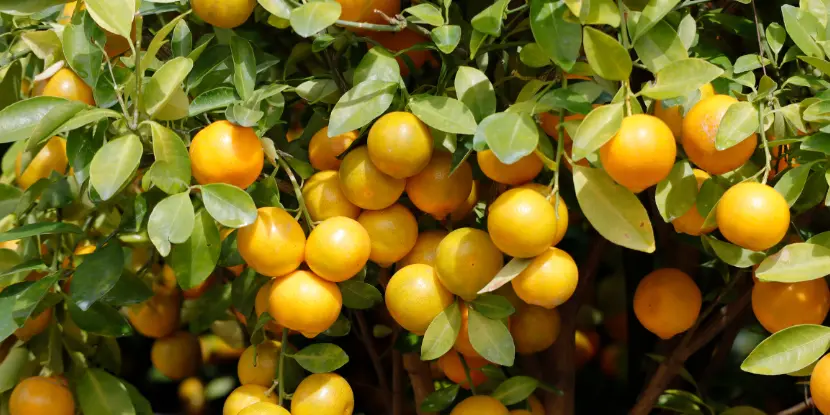
A lemon tree laden with fruit.
Pests & Diseases
Common Pests
- Aphids: These tiny insects suck on plant sap, making leaves curl and turn yellow. Manage them by spraying an insecticidal soap solution.
- Citrus Leafminer: The larvae of this tiny moth tunnel into new leaf growth, causing distorted and discolored foliage. Use sticky traps or beneficial insects to control them.
- Whiteflies: These tiny, white insects suck on plant sap and leave behind a sticky residue called honeydew, which attracts ants and can lead to sooty mold. Use insecticidal soap or horticultural oil to control them.
Common Diseases
- Citrus Canker: This bacterial disease causes raised, corky lesions on leaves, stems, and fruit. Prune off affected branches and dispose of them properly.
- Citrus Black Spot: This fungal disease causes black spots on leaves and fruit. Keep the area around the tree clean and debris-free to prevent infection.
- Citrus Greening: A serious bacterial disease that affects the tree’s vascular system, causing it to decline rapidly. There’s no cure for citrus greening; remove infected trees should immediately.
- Root Rot: Overwatering and poorly draining soil can lead to root rot, which causes yellowing leaves and stunted growth. Improve drainage and cut back on watering to prevent this disease.
Special Note
All citrus trees are vulnerable to freezing and should be protected during severe cold spells.

A flowering Valencia orange tree.
FAQs: Caring for Citrus Trees
Q: What’s the best time of year to plant citrus trees in Southern California?
The ideal time to plant citrus trees is in the early spring, after the last chance of frost, to give your tree a full growing season.
Q: How often should I water my citrus trees?
Citrus trees need deep watering once or twice a week. Adjust your watering schedule according to the season. Trees need more water during dry, hot months and less during the cooler months.
Q: Do citrus trees require a specific type of soil?
Citrus trees thrive in well-draining, slightly acidic soil. Amending your soil with compost can improve soil health and drainage.
Q: When and how should I fertilize citrus trees?
Fertilize citrus trees three times a year — spring, summer, and fall — with a balanced, slow-release citrus fertilizer to ensure they receive the necessary nutrients.
Q: How much sun do citrus trees need?
Citrus trees require full sun, which means at least 6-8 hours of direct sunlight daily for optimal growth and fruit production.
Q: What common pests affect citrus trees in California, and how can I control them?
A: Common pests include aphids, spider mites, and citrus leafminers. Control them with horticultural oils or insecticidal soaps and promote beneficial insects.
Q: When is the best time to prune citrus trees, and what’s the proper way?
The best time to prune is in the spring, after the last frost. Remove dead or diseased branches and thin out the canopy to allow light and air to reach the inner branches.
Q: How do I protect my citrus trees from frost in winter?
Cover them with frost cloth or blankets, using string lights for warmth, and watering the ground around the trees to increase humidity.
Q: Why are my citrus tree’s leaves turning yellow, and what can I do about it?
Yellow leaves may indicate overwatering, nutrient deficiency, or a pest problem. Adjust your watering schedule, ensure proper fertilization, or inspect for pests.
Q: Can I grow citrus trees in containers, and if so, what should I consider?
Yes. Choose a large, well-draining pot with a potting mix formulated for citrus or other fruit trees.

